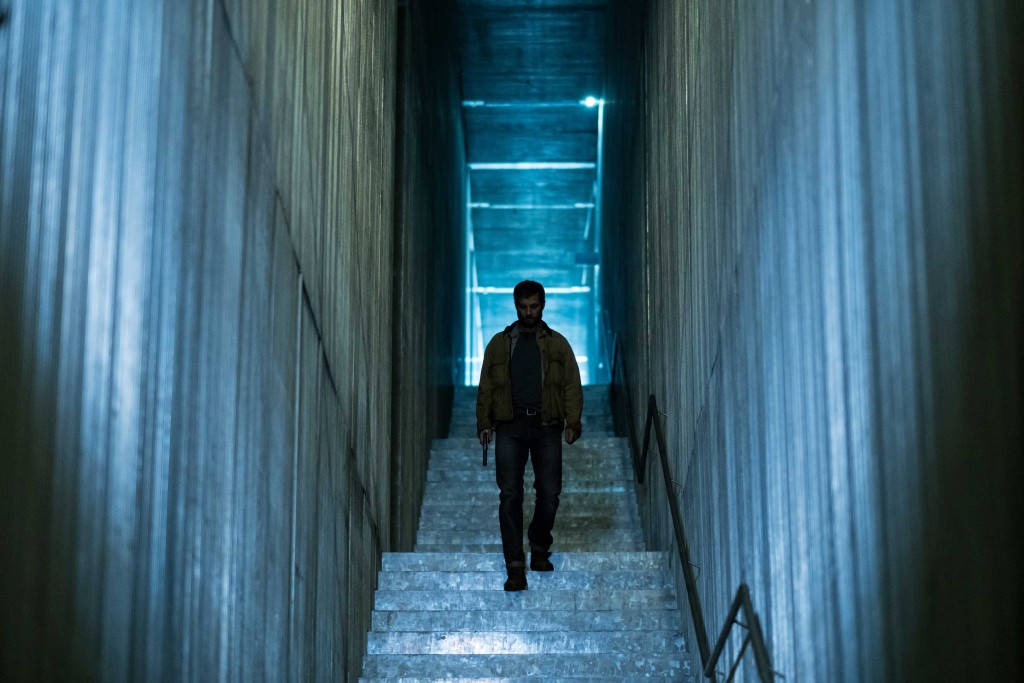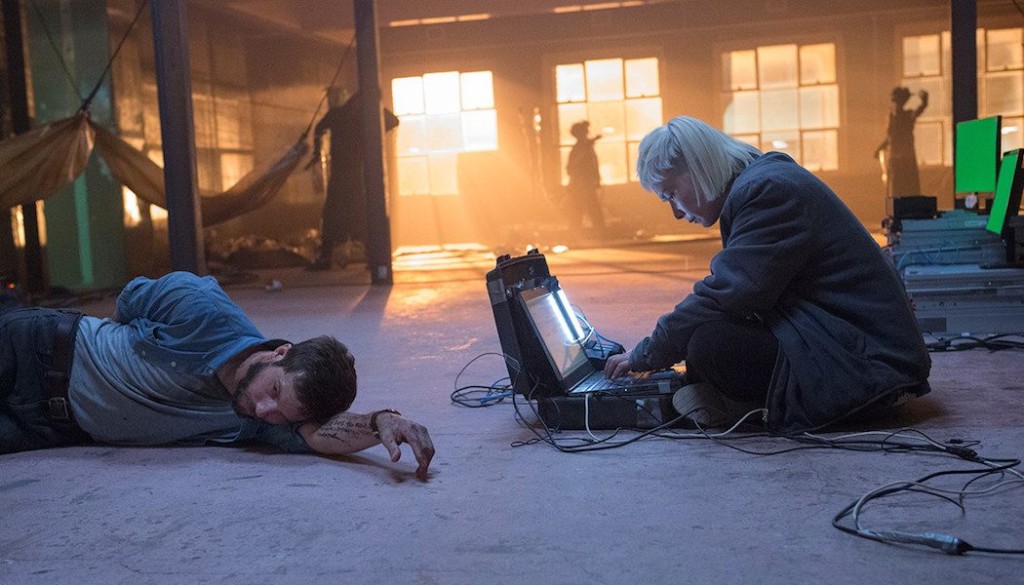Genre: Sci-Fi
Premise: (from IMDB) Set in the near-future, technology controls nearly all aspects of life. But when Grey, a self-identified technophobe, has his world turned upside down, his only hope for revenge is an experimental computer chip implant called Stem.
About: Writer-director Leigh Whannel had been working with the Blumhouse team for awhile, even directing one of their films, Insidious: Chapter 3. But what Whannel REALLY wanted to do was make his dream project, a sci-fi flick about a paraplegic who gains the power to move again via futuristic technology. The problem was that the budget for his movie was AT LEAST 30 million, probably more. The film, which was set in the future, had elaborate fight scenes, groundbreaking camera work, and self-driving car chases. But instead of going out and trying to fetch that kind of money from financiers or a studio – a task that some filmmakers spend their entire careers trying to do – he decided to stay in house, telling Jason Blum that he would make the movie for a Blumhouse-friendly 5 million dollars. Blum took a chance on Leigh, and that risk resulted in an underground hit. While the movie didn’t do as well at the box office as they had hoped, it was lauded by critics (85% on RT) and anyone who went to see it.
Writer: Leigh Whannel
Details: 100 minutes
One of the stranger moments I’d had in a movie theater this year was watching the trailers for Upgrade and Venom back to back. The audience and I stared up at the screen, confused. Uhhh, did we just see the same trailer? Guy gets taken over by something that controls his body and then the thing inside him beats up a lot of bad guys. Originality really is dead I guess!
I didn’t know what to make of Upgrade. The casting of an actor you only vaguely recognize in a sci-fi film is usually a guarantee the film will be awful. You can count the number of sci-fi films that have come out of nowhere and been good on one hand. So I didn’t think much of it. But then I started to hear people online praise the film. I even had a couple of friends tell me to check it out as soon as possible.
I did some digging and learned the particulars of the project – how Blumhouse was trying to expand out of horror – and realized that the movie was sort of an experiment. Could Blum do the same thing for the sci-fi formula that he did for the horror formula (basically, make them for super-cheap)?
I was skeptical. The reason horror is cheap is because scaring people doesn’t cost a lot of money. Stick a woman in a nun costume, add some creepy make-up, place that character in the shadows a few times and as long as the story is decent, the audience feels like they’ve gotten their money’s worth.
In the case of sci-fi, the audience’s demands are much higher. They want effects. They want action. They want cool sci-fi eye candy. None of these things come cheap. If you pinch pennies on a chase scene, we’re going to know it. Just to give you some reference on how difficult it is to make a movie with all these things for 5 million dollars, Ex Machina, which took place in a single location and had no action scenes, cost 15 million dollars.
But I strolled into this one with an open mind. Let’s see how it turned out.
Set in a near future where human-computer augmentation is becoming as ubiquitous as upgrading your phone, mechanic Grey Trace refuses to upgrade. That shit destroys your humanity is the way he sees it.
One day he’s driving with his wife and the two get cornered in a seedy part of town. Out of nowhere a bunch of men pop out of a car, kill his wife, then shoot Grey in his spine. This means that Grey survives, but he’s a paraplegic.
While recovering in the hospital, a rich client of his, Eron, says he has something that can help Grey walk again. It’s a new super-intelligent chip he’s created called “Stem.” Of course Grey wants in, and the next thing he knows he’s got a pseudo second brain in him that can control his limbs.
There’s a catch, though. This second brain is its own “Hal,” and can communicate with Grey. Now that Grey can move again, he decides to find out who killed his wife and why. One by one, he corners the attackers from that fateful night, and then allows Stem to kick their asses (Stem can move Grey’s body at computer-like speeds).
While at first, Stem works in tandem with Grey, it’s clear that he wants more control. We get the feeling that if left to its own devices, Stem would get rid of Grey completely. So Grey will not only need to find his wife’s killer, but figure out what to do with Stem… before Stem figures out what to do with him.
Hmmmmmm…
I don’t know about this one.
It definitely wasn’t as good as everyone hyped it up to be. There were too many sci-fi tropes in play. This idea of people being upgraded has been around for 50 years. Having something in your head talking to you is a well-worn trope. The plot itself is Robocop meets The Matrix and Blade Runner.
It was hard to find the originality within all that.
I liked the visual language Whannel created in his fight scenes. The way the camera moved with the character, who, himself, fought with a strange puppet-like urgency (due to being controlled), was something I’d never seen before.
And the dramatic irony inherent in the “disguised superhero” format made for some fun scenes. What does that mean? One of the reasons disguised superhero movies work is that when our civilian clothed superhero gets in a jam, we know something that that bad guys do not. That he’s a superhero! This adds a charge to the scene since we can’t wait for the cocky bad guy to get his head bashed in.
When Grey rolls into a bar in his paraplegic wheelchair and starts talking shit to everyone and they all laugh at him, we’re the ones laughing inside. We know that they’re all in deep shit. And it’s supercharged because he isn’t just a normal schmoe. He’s as handicapped as a person can be.
But the script begins to falter as it moves beyond the “fun and games” section of the story. The “Stem” thing was kind of confusing. At first I thought it was a computer that helped him. But then it develops its own agenda, and once that happens, it becomes a completely different movie about fighting the brain inside of him. That was never interesting to me.
Also, I was never clear on who these “upgraded” guys were that were chasing him. The Matrix establishes “Agents” in the VERY FIRST SCENE of the movie. Later, Morpheus explains VERY CLEARLY who the agents are and what they’re capable of. This is why Agent Smith and his team make such a strong impact. The guys chasing Grey in Upgrade seemed to be there simply because the story needed guys to chase Grey. They weren’t well-established at all.
This is par for the course on writer-director projects where the artist is more director than writer. So I was surprised to learn that Leigh actually has an extensive background in screenwriting, writing the Saw and Insidious movies.
I see Blum struggling if he continues to outsource his horror formula to science-fiction. Audiences don’t grade on a curve. They don’t give you points for entertaining them on lower budgets. All movie tickets cost the same, which means they’re going to judge you just as harshly as they do an Avengers film. Is that fair? No. But it’s reality. So while I was impressed as hell with how much they were able to get out of such a small budget, Joe Moviegoer has no idea and doesn’t care how much Upgrade costs. He just knows whether it’s good or bad. And the truth is, even with how much bang Leigh got for his buck, Upgrade still feels small in places where it needed to feel big. It still takes place mostly in rooms. The special effects are neat but never jaw-dropping.
With that said, if I’m taking everything into account here, I’d say Upgrade’s worth checking out on digital. As hard as I’ve been on it, it’s waaaaaay better than those movies that go straight to digital (Singularity, Anon, Beyond Skyline). I’d even place it above Blade Runner 2049, which cost 30 times as much to make. The only way you’re going to have a problem with this movie is if you go into it with unrealistic expectations. It’s a fun little sci-fi flick and that’s okay.
[ ] What the hell did I just watch?
[ ] wasn’t for me
[x] worth the price of admission
[ ] impressive
[ ] genius
What I learned: It seems weird that I should have to point this out, but you have to ESTABLISH who characters are in a screenplay. If we don’t know who the people are that are chasing your hero, if they just show up out of nowhere and begin beating your hero up, why should we be invested in that? We don’t know who they are! It’s your job to tell us who they are and what their motivation is so that we understand why they’re chasing your hero. That way we’re clear on what everybody wants.



